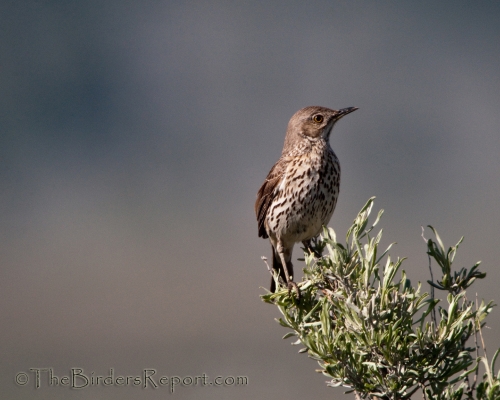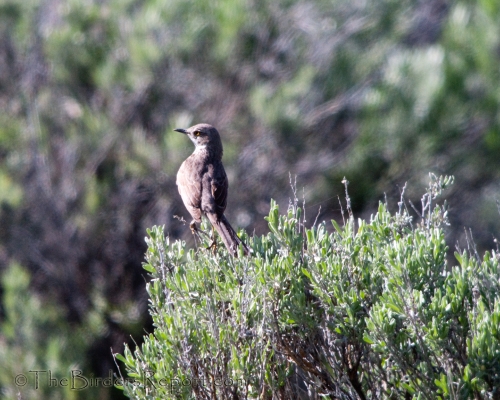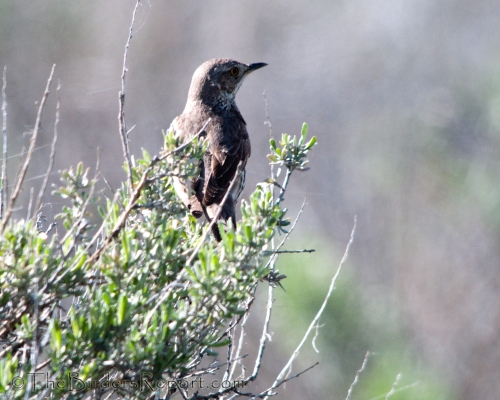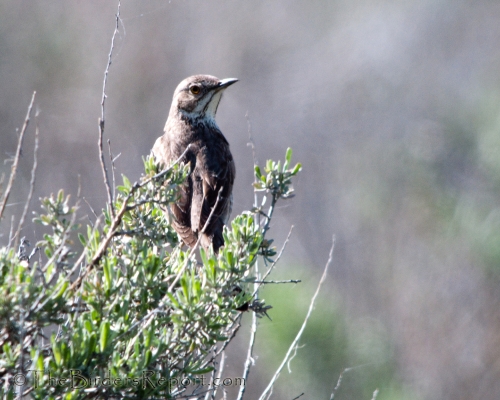 Sage Thrasher (Oreoscoptes montanus) photos by Larry Jordan
Sage Thrasher (Oreoscoptes montanus) photos by Larry Jordan
Recently I was invited by the Plumas Audubon Society to give a presentation on the Burrowing Owl in Quincy, California. We had a great turnout for the presentation, as well as for the installation of an artificial Burrowing Owl habitat the following day in Portola, a nearby town in the Sierra Valley.
The Sierra Valley is a beautiful inter-mountain valley that sits at a 4850 foot elevation. The valley floor has a grassland and sagebrush ecosystem and is the site of extensive freshwater marshes filled with cattails, bulrushes and alkaline flats that drain into the middle fork of the Feather River1.
It is here that I saw my first Sage Thrasher (Oreoscoptes montanus). Click on photos for full sized images.
When my friend Jerry took me out to a recently completed wildlife viewing platform at Maddalena Ranch, a joint project of the Plumas Audubon Society and the Feather River Land Trust, he assured me that I would see my target bird. He told me that sometimes the Sage Thrashers would be perched on the viewing platform singing.
As we walked out to the platform, we saw a Short-eared Owl flying over the wetlands just before spotting the thrasher on a fence post singing away.
They would also pop up to the tops of the sagebrush and sing long uninterrupted songs.
I came back to the Maddalena Ranch later that afternoon to get these photos.
I have since discovered that the Sage Thrasher depends on sagebrush throughout most of its range for nesting habitat.
This species is on the British Columbia Environment Red List, meaning it is under consideration for Endangered and Threatened status. Only 700 hectares of good habitat remain in Okanagan, Similkameen, and Thompson Valleys of British Columbia. Further, Sage Thrasher is considered to be “critically endangered” in Canada by Conservation Data Center and “endangered” by Committee on the Status of Endangered Wildlife in Canada.
In the U.S., this thrasher is listed as species of concern by the State of Washington; it is being considered for listing as Washington Endangered, Threatened, or Sensitive species. In interior Columbia River basin, this species is of high concern to management because of historic habitat losses and projected losses over the next 10 years2.
Large swaths of land are in the hands of private landowners in the U.S. Thank goodness some of these landowners are partnering with organizations like the Feather River Land Trust, Shasta County Land Trust, The Nature Conservancy and others to save some of this dwindling habitat for future generations.
To see more great bird photos, check out Bird Photography Weekly!
References: 1 Wikipedia, 2 Birds of North America Online













Comments on this entry are closed.
A beautiful little bird and its song is lovely. It would certainly be sad if it was lost because of loss of habitat. I wish people could learn to take better care of our planet.
I imagine construction of homes, etc… is to blame. It’s everywhere. And it’s a sad commentary on today’s society.
I hope they are able to save this beautiful bird. Great post, Larry. Thank you for sharing this information. 🙂
Great post and timely, we plan to camp soon up at Burney Falls and Lassen and may come back by way of Quincey. Your links have great info on that area.
Second post I’ve read today about birds moving toward endangered or threatened status. Thank heavens there are organizations working to protect habitat for these declining birds – they deserve our support.
A lovely and informative post. Thanks for sharing.